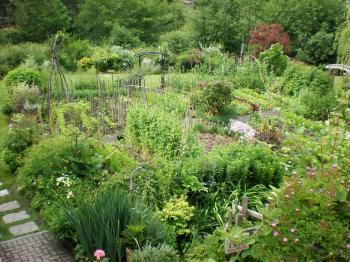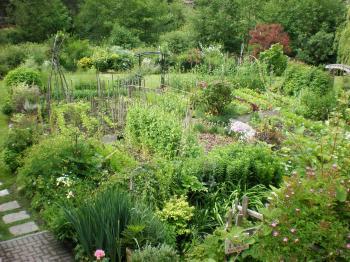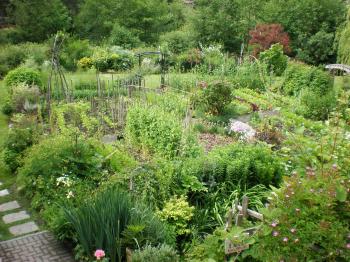As the urban farming movement gathers momentum, people are increasingly looking to their own backyards rather than supermarket shelves for their fresh produce.
And if they don’t have a yard, they’re being very creative about where to plant their veggies, says Carolyn Herriott, a writer and organic gardener who’s passionate about growing her own food.
“People are being very inventive. There’s rooftop gardening, and they’re doing this horizontal gardening, and on walls, and people are growing food in old bathtubs—anything they can get their hands on.”
At the Garden Path Centre in Victoria, Herriott gives workshops on the Zero Mile Diet, in which she shares tips on food security and how to grow organic vegetables, fruits, and herbs year round.
She also gives lectures and workshops on a host of other topics, including the basics of organic gardening, growing vegetables in containers, “edible landscaping,” how to save seeds, backyard fruits and berries, and growing a winter food garden.
And if they don’t have a yard, they’re being very creative about where to plant their veggies, says Carolyn Herriott, a writer and organic gardener who’s passionate about growing her own food.
“People are being very inventive. There’s rooftop gardening, and they’re doing this horizontal gardening, and on walls, and people are growing food in old bathtubs—anything they can get their hands on.”
At the Garden Path Centre in Victoria, Herriott gives workshops on the Zero Mile Diet, in which she shares tips on food security and how to grow organic vegetables, fruits, and herbs year round.
She also gives lectures and workshops on a host of other topics, including the basics of organic gardening, growing vegetables in containers, “edible landscaping,” how to save seeds, backyard fruits and berries, and growing a winter food garden.
Learning how to grow food helps people become educated about the link between food quality and good health, she says, lamenting that the commodification of food through agribusiness has resulted in people becoming disconnected from growing their own.
“We need to put the culture back into the word agriculture… It’s not just about farming and local food and getting out in the garden and teaching your children how to grow food. There’s a whole cultural association that’s connected with this, and it’s good because it actually brings people together. It connects you with community, and that’s what we’ve lost.”
However, she adds, awareness of food sustainability and the switch from growing flowers to food has increased noticeably in the past year.
“It’s just a little shift, that’s all, so that you grow things that you can eat instead of things that just look pretty.”
Herriott’s lush display garden includes flower and vegetable plots, a wedding arbour, a huge weeping willow, a “forest house”—and three Muscovy ducks called Benny, Betty, and Blackie. She is author of “A Year on The Garden Path,” and produces her own line of certified organic, open-pollinated seeds. She also teaches an eight-month course on how to build an edible plant business.
She says the Zero Mile Diet, which involves growing one’s own food, has been “hugely popular” as people are becoming increasingly aware of the importance of food security.
The quickest and easiest type of garden to grow is the lasagna garden, also known as sheet composting. Simply pick a spot in your yard that gets a minimum of seven to 11 hours of sunlight. Then put down cardboard as a buffer and begin layering on a variety of mixed organic matter, such as leaves, spoiled hay, grass clippings or manure.
Once the material is built up to about 12 inches a garden can be planted immediately—there is no digging, tilling, or any need to work the soil. As the compost breaks down and the plant grows it receives an abundance of nutrients from the compost. Voila—you have your food for the Zero Mile Diet right there, just steps away from the kitchen.
“It’s all free, and anybody can do this,” says Herriott.
What with climate change and the global recession, Herriott believes that “the time is now” to get going on creating more food security.
“What kind of things can you do when you’ve got very little money and a lot of time on your hands? Get out there and grow a nice food garden.”
“We need to put the culture back into the word agriculture… It’s not just about farming and local food and getting out in the garden and teaching your children how to grow food. There’s a whole cultural association that’s connected with this, and it’s good because it actually brings people together. It connects you with community, and that’s what we’ve lost.”
However, she adds, awareness of food sustainability and the switch from growing flowers to food has increased noticeably in the past year.
“It’s just a little shift, that’s all, so that you grow things that you can eat instead of things that just look pretty.”
Herriott’s lush display garden includes flower and vegetable plots, a wedding arbour, a huge weeping willow, a “forest house”—and three Muscovy ducks called Benny, Betty, and Blackie. She is author of “A Year on The Garden Path,” and produces her own line of certified organic, open-pollinated seeds. She also teaches an eight-month course on how to build an edible plant business.
She says the Zero Mile Diet, which involves growing one’s own food, has been “hugely popular” as people are becoming increasingly aware of the importance of food security.
The quickest and easiest type of garden to grow is the lasagna garden, also known as sheet composting. Simply pick a spot in your yard that gets a minimum of seven to 11 hours of sunlight. Then put down cardboard as a buffer and begin layering on a variety of mixed organic matter, such as leaves, spoiled hay, grass clippings or manure.
Once the material is built up to about 12 inches a garden can be planted immediately—there is no digging, tilling, or any need to work the soil. As the compost breaks down and the plant grows it receives an abundance of nutrients from the compost. Voila—you have your food for the Zero Mile Diet right there, just steps away from the kitchen.
“It’s all free, and anybody can do this,” says Herriott.
What with climate change and the global recession, Herriott believes that “the time is now” to get going on creating more food security.
“What kind of things can you do when you’ve got very little money and a lot of time on your hands? Get out there and grow a nice food garden.”









Friends Read Free